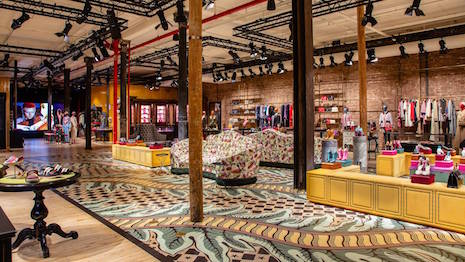- About
- Subscribe Now
- New York,
December 10, 2018

 Supreme gets the street zeitgeist: Supreme store in Tokyo's Shibuya-ku district. Image credit: Supreme
Supreme gets the street zeitgeist: Supreme store in Tokyo's Shibuya-ku district. Image credit: Supreme
By Ana Andjelic
Fashion has long employed the wait-and-see approach to its own change. Sometimes that means weathering the trends (Crocs, anyone?), and other times missing them and having to play catch up (sneakers, ecommerce, customer experience).
If I had to outline the biggest challenges for the global fashion industry right now, they would be among the following.
Structure is complex
Luxury fashion’s biggest internal challenge is its outdated organizational structure.
Notable examples aside, fashion brands are still mostly hierarchical, heavily siloed enterprises, where departments often compete with each other for clout and resources.
Blame the old PR-merchandising complex, where both public relations and merchandising wield an outsized influence on what gets made and pushed into the hands of consumers.
When the consumer is hyper-connected, informed and fickle, this organizational format and its power centers do not cut it anymore.
Fashion companies really need to become always-on, responsive organizations that have no difficulty sharing data and intelligence from different teams, integrating their online and offline touch points, and organizing around their customer journey.
No sitting it out
Luxury fashion has so far weathered successfully the China tariffs war, but is still faced with a number of external challenges.
Transformation of the physical stores is top of the list, with only a limited number of brands actively modernizing their physical retail spaces.
There is much left to be desired in terms of a seamless customer experience (start with a free in-store Wi-Fi, continue with technology-empowered customer service), data integration and CRM, options for Apple and Alipay, and for quickly locating and delivering products to customers across stores and fulfillment centers.
This technology-powered customer experience is accompanied by a broader shift in the culture of luxury stores.
Gucci is one of the rare brands that successfully changed the “you can’t sit with us” vibe prevalent in much of the luxury fashion establishment by welcoming and offering comfortable seating with couches, easily accessible and touchable products, water and coffee, and no-commission salespeople who are there mostly to helpfully chat with you.
 Boho in SoHo: Gucci's store on 63 Wooster Street in New York that officially opened in May. Image credit: Gucci
Boho in SoHo: Gucci's store on 63 Wooster Street in New York that officially opened in May. Image credit: Gucci
Big picture
After showing up early to the party some years ago, social commerce is making its resolute comeback.
Instagram’s shopping application will emphasize what and whose look people are buying, not from where are they buying.
If anyone has been paying attention to what is going on over at Depop, they will glimpse a future where the sellers are also the stylists, models, community hubs and micro-influencers all at the same time.
Moving down the list, luxury fashion still has yet to crack the code of experiential consumption and evolve its business models and revenue streams so it can be profitable even before the consumer makes a single product purchase.
For an industry whose revenues depend heavily on product sales, this is a massive challenge. But with younger consumers spending less on physical goods and more on their own personal transformation, wellbeing and experiences, luxury fashion needs to diversify its moneymaking tactics.
On Dec. 6, Burberry announced its collaboration with Vivienne Westwood, mostly prompting questions of why it did not happen sooner.
Collaborations in fashion are the new competition, as long as they make sense for both brands in terms of their shared cultural territory.
Word on the street
Luxury fashion has been obsessed with streetwear for a while now, but it hardly moved this obsession beyond products such as hoodies and sneakers into the retail models and communication tactics promoted by streetwear.
Now we are seeing brands tentatively testing the waters with drops, such as Burberry and Gucci did earlier this year. Limited editions are yet to be unlocked and quickly, since young consumers are obsessed with exclusivity.
There is much to learn from Supreme, which mastered the art of distinction. In this model, a brand is an umbrella for a portfolio of unique products, where a large part of its audience owns unique brand products, with the limited number of people owning the exact same thing.
For the first time, luxury fashion is now also directly competing with everyone from Supreme to Nike and Adidas to Yeezy and Goop.
Casualization and mixing formalwear with streetwear is only partly to blame.
Cultural currency around high-end products has now expanded to styling, a personal point of view, uniqueness, and a social message rather than having a head-to-toe designer look.
Shemale
The ideas of masculinity and femininity are changing as well, and luxury fashion brands have to adapt.
The James Bond alpha-males are no longer the status symbol, nor are hyper-sexualized clothes for women, if the consumer backlash after Hedi Slimane’s first Celine collection is any indicator.
Women want to dress based on their own perception of their own identity, and so do men. Today, this perception is evolving and fluid.
Just as Gucci and Balenciaga prove, campaign imagery and brand ambassadors who once fit into neat gender categories and represented masculine or feminine ideals feel increasingly irrelevant and old-fashioned.
WHILE A LOT of luxury fashion brands talk about millennials and tout their millennial-first strategy, the real challenge is switching it into execution.
 Ana Andjelic
Ana Andjelic
Ana Andjelic is a New York-based brand growth leader, doctor of sociology and startup advisor. She was named to Forbes CMO Next 2018 list. Reach her at andjelicaaa@gmail.com.
Share your thoughts. Click here